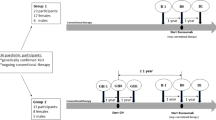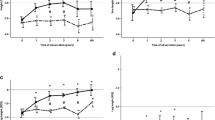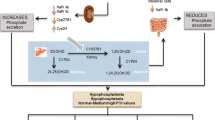Abstract
The role of phosphate in short-statured patients with X-linked hypophosphatemic rickets (XLH) was investigated. Plasma insulin-like growth factor (IGF)-I levels were within the normal range in XLH patients. After oral phosphate loading, plasma IGF-I levels increased clearly in XLH patients, while there were no changes in normal controls. Plasma IGF-I levels significantly correlated with the maximal serum parathyroid hormone (PTH) concentrations in XLH patients. Plasma PTH concentrations and nephrogenic cyclic AMP values were increased significantly in XLH patients compared with normal controls. The former values correlated significantly with the increments of serum phosphate concentrations. The increase of serum PTH concentrations did not correlate either with the decrease of serum calcium concentrations or with the serum 1,25-dihydroxyvitamin D concentrations in either XLH patients or the normal controls. A 1-34 human PTH loading test revealed a clear increase of the plasma IGF-I levels in two XLH patients, while there was no change in the normal controls. The height SD scores of XLH patients significantly correlated with the maximal increase of plasma IGF-I concentrations. These data suggest that the increased IGF-I levels via PTH were in part supposed to restore the IGF action resulting in improved growth in XLH patients due to phosphate therapy.
Similar content being viewed by others
References
McNir SL, Stickler GB (1969) Growth in familial hypophosphatemic vitamin D resistant rickets. N Engl J Med 281:511–516
Scriver CR, Tenenhouse HS, Glorieux FH (1991) X-linked hypophosphatemia: an appreciation of a classic paper and a survey of progress since 1958. Medicine (Baltimore) 70:218–228
Read AP, Thakker RV, Pavies KE, Mountford RC, Brenton DP, Davious M, Glorieux FH, Harris R, Hendy GN, King A, McGlade S, Peacock CJ, Smith R, O'Riordan JLH (1986) Mapping of human X-linked hypophosphatemic rickets by multilocus linkage analysis. Hum Genet 73:267–270
The Hyp Consortium (1995) A gene (PEX) with homologies to endopeptidases is mutated in patients with X-linked hypophosphatemic rickets. Nature Genet 11:130–136
Meyer R, Tenenhouse HS, Meyer MH, Klugerman AH (1989) The renal phosphate transport defect in normal mice parabiosed to X-linked hypophosphatemic mice persists after parathyroidectomy. J Bone Miner Res 4:523–532
Nesbitt T, Coffman TM, Griffiths R, Drezner MK (1992) Cross-transplantation of kidneys in normal and Hyp mice: Evidence that Hyp mouse phenotype is unrelated to an intrinsic renal defect. J Clin Invest 89:1453–1459
Eicher EM, Southard JL, Scriver CR, Glorieux FH (1976) Hypophosphatemia: mouse model for human familial hypophosphatemic (vitamin D-resistant) rickets. Proc Natl Acad Sci USA 73:4667–4671
Lobaugh B, Drezner MK (1983) Abnormal regulation of renal 25-hydroxy-vitamin D-1α-hydroxylase activity in the X-linked hypophosphatemic mouse. J Clin Invest 71:400–403
Yamaoka K, Seino Y, Satomura K, Tanaka Y, Yabuuchi H, Haussler MR (1986) Abnormal relationship between serum phosphate concentration and renal 25-hydroxycholecalciferol-l-alpha-hydroxylase activity in X-linked hypo-phosphatemic mice. Miner Electrolyte Metab 12:194–198
Nesbitt T, Drezner MK, Lobaugh B (1986) Abnormal parathyroid hormone stimulation of 25-hydroxyvitamin D-1α hydroxylase activity in the hypophosphatemic mouse: evidence for a generalized defect of vitamin D metabolism. J Clin Invest 77:181–187
Seino Y, Yamaoka K, Ishida M, Tanaka Y, Kurose H, Yabuuchi H, Tohira Y, Fukushima M (1982) Plasma clearance for high dose of exogenous 1,25-dihydroxy[23,24(n)-3H] cholecalciferol in X-linked hypophosphatemic mice. Biomed Res 3: 683–687
Tenenhouse HS, Yip A, Jones G (1990) Increased renal catabolism of 1,25-dihydroxyvitamin D3 in murine X-linked hypophosphatemic rickets. J Clin Invest 85:1450–1455
Tenenhouse HS, Jones G (1990) Abnormal regulation of renal vitamin D catabolism by dietary phosphate in murine X-linked hypophosphatemic rickets. J Clin Invest 85:1450–1455
Yamamoto T, Seino Y, Tanaka K, Yamaoka K, Kurose H, Ishida M, Yabuuchi H (1988) Effects of the administration of phosphate on nuclear 1,25-dihydroxyvitamin D3 uptake by duodenal mucosal cells of Hyp mice. Endocrinology 122:576–580
Nakajima S, Yamaoka K, Yamamoto T, Okada S, Tanaka H, Seino Y (1990) Decreased concentration of 1,25-dihydroxyvitamin D3 receptors in peripheral mononuclear cells of patients' supplementation. Bone Miner 10:201–209
Nakajima S, Yamaoka K, Okada S, Pike JW, Seino Y, Haussler MR (1992) 1,25-dihydroxyvitamin D3 does not up-regulate vitamin D receptor messenger ribonucleic acid levels in hypophosphatemic mice. Bone Miner 19:201–213
Marie M, Glorieux FH (1983) Relation between hypomineralized periosteocytic lesions and bone mineralization in vitamin D-resistant rickets. Calcif Tissue Int 35:443–448
Ecarot-Charrier B, Glorieux FH, Travers R, Desbarats M, Bouchard F, Hineck A (1988) Defective bone formation by transplanted Hyp mouse bone cells into normal mice. Endocrinology 123:763–773
Yamamoto T, Ecarot-Charrier B, Seino Y, Glorieux FH (1990) Familial hypophosphatemia: altered regulation of osteocalcin synthesis in bone cells. In: Cohn DV, Glorieux FH, Martin TJ (eds) Calcium regulation and bone metabolism. Elsevier Science Publishers, Amsterdam, pp 239–241
Yamamoto T, Ecarot B, Glorieux FH (1992) Abnormal response of osteoblasts from Hyp mice to 1,25-dihydroxyvitamin D3. Bone 13:209–215
Glorieux FH, Scriver CR, Reade TM, Goldman H, Roseborough A (1972) Use of phosphate and vitamin D to prevent dwarfism and rickets in X-linked hypophosphatemia. N Engl J Med 287:481–487
Yamaoka K, Tanaka H, Kurose H, Shima M, Ozono K, Nakajima S, Seino Y (1989) Effect of single oral phosphate loading on vitamin D metabolites in normal subjects and X-linked hypophosphatemic rickets. Bone Miner 7:159–169
Ishida M, Seino Y, Shimotsuji T, Ishii T, Yamaoka K, Harada T, Yabuuchi H, Nishimura K (1980) Differential diagnosis of hypoparathyroid disorders during childhood. Calcif Tissue Int 31:203–207
Furlanetto RW, Underwood LE, Van Wyk JJ, D'Erocole J (1977) Estimation of somatomedin-C levels in normals and patients with pituitary disease by radioimmunoassay. J Clin Invest 60:648–657
Glorieux FH, Marie PJ, Pettifor JM, Delvin EE (1980) Bone response to phosphate salts ergocalciferol, and calcitriol in hypophosphatemic and vitamin D-resistant rickets. N Engl J Med 303:1023–1031
Verge CF, Lam A, Simpson JM, Coroell CT, Haward N, Silink M (1991) Effects of the therapy in X-linked hypophosphatemic rickets. N Engl J Med 325:1843–1848
Wilson DM, Lee PDK, Morris AH, Reiter EO, Gertner JM, Marcus SR, Quarmby VE, Rosenfeld RG (1991) Growth hormone therapy in hypophosphatemic rickets. Am J Dis Child 145:1165–1170
Lanes R, Harrison HE (1990) Growth hormone therapy in a poorly growing child with hypophosphatemic rickets. J Endocrinol Invest 13:833–838
Caverzasio J, Ecarot B, Glorieux FH, Bonjour JP (1992) X-linked hypophosphatemic mouse: IGFI levels and serum activity on in vitro renal Pi transport. In: Cohn PV, Gennari C, Tashjian Jr AH (eds) Calcium regulating hormones and bone metabolism: Basic and clinical aspects. Elsevier Science Publishers, Amsterdam, pp 437–440
Moriwake T, Abribat T, Brazean P, Ecarot B (1995) Serum insulin-like growth factor binding protein-3 in the hypophosphatemic mouse: Decreased activity and abnormal modulation by dietary phosphate. J Bone Miner Res 10:1698–1704
Coxam V, Davicco MJ, Durand D, Bauchart D, Bazlet JP (1990) Parathyroid hormone and calcitonin may modulate hepatic IGF-I production in calves. Acta Endocrinol (Copenh) 123:471–475
Linkhart T, Mohan S (1989) Parathyroid hormone stimulates release of insulin-like growth factor-I (IGF-I) and IGF-II from neonatal mouse calvaria in organ culture. Endocrinology 125: 1484–1491
Reusz GS, Latta K, Hoyar PF, Byrd DJ, Ehrich JHH, Brodehl J (1990) Evidence suggesting hyperoxaluria as a cause of nephrocalcinosis in phosphate treated hypophosphatemic rickets. Lancet 335:1240–1243
Author information
Authors and Affiliations
About this article
Cite this article
Yamamoto, T., Ozono, K., Yamaoka, K. et al. The role of IGF-I in phosphate therapy for the short stature of patients with hypophosphatemic vitamin D-resistant rickets. J Bone Miner Metab 14, 222–228 (1996). https://doi.org/10.1007/BF01763822
Received:
Accepted:
Issue Date:
DOI: https://doi.org/10.1007/BF01763822




